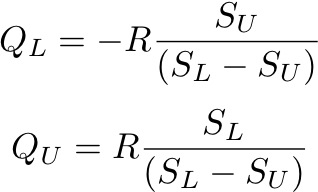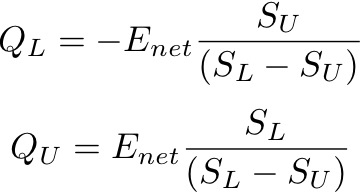MPO
503: Introduction to Physical Oceanography
Notes:
Basins
are regions of enclosed water semi-isolated from the open
oceans.

where:

Solving the system for QU and QL, we obtain:

The relations for QU and QL, known as Knudsen relations, allow us to draw some conclusions about the 2-layer circulation:
2. Evaporative basin

Here, there is a net evaporation Enet equal to difference between the loss of freshwater due to evaporation (E) and the input by land runoff (R) and precipitation (P):

Analogously to the estuarine basin case, we have:

Solving for QU and QL, we obtain:

Now, let’s use the Knudsen relations to estimate the QL and QU exchanged between the Atlantic ocean and the Mediterranean sea across the Gibraltar Strait, given Enet, SL and SU:

Note that, because (SL - SU) is small, the inflow/outflow transports are 20 times larger than the net loss of mass due to evaporation on the Mediterranean basin.
Practical problems on for this estimation:
3. Physical differences between estuarine and evaporative basins:
- Estuarine basins: where riverine input flows out to fill an estuaries before connecting with the sea. Characterized by a gain in freshwater (buoyancy) where fresh water flows out at the surface and saltier water flows in at depth.
- Evaporative basins: where the basin separated from the ocean by a sill/strait. Characterized by a loss of freshwater, or buoyancy, where freshwater flows in at the surface, and saltier water flows out at depth.
By considering the mass & salt budgets over the basin, we can predict the size of exchange flow at the sill/strait or mouth.
1. Estuarine basin

where:
- R
is the riverine input;
- QU and QL are the transport of mass at the upper (U) and lower (L) layers;
- SU and SL are the salinity of the upper and lower layers.
For a steady circulation, we have that:

Solving the system for QU and QL, we obtain:

The relations for QU and QL, known as Knudsen relations, allow us to draw some conclusions about the 2-layer circulation:
- For (SL - SU) > 0, the lower layer flow has opposite sign to the upper layer;
- Mixing reduces (SL - SU) and increases (QL + QU) along the estuary. By measuring salinity profiles in different coordinates along the estuarine channel we can quantify the mixing that occurs in the zone between the profiles;
- Near the ocean (SL - SU) will be smaller and hence the fluxes will be larger;
- The
along-estuary difference in the inflowing water, QL,
must equal the amount of water mixed vertically into the
upper layer.
2. Evaporative basin

Here, there is a net evaporation Enet equal to difference between the loss of freshwater due to evaporation (E) and the input by land runoff (R) and precipitation (P):

Analogously to the estuarine basin case, we have:

Solving for QU and QL, we obtain:

Now, let’s use the Knudsen relations to estimate the QL and QU exchanged between the Atlantic ocean and the Mediterranean sea across the Gibraltar Strait, given Enet, SL and SU:
- Net evaporation (Enet ) = 0.55 x 105 m3s-1~ 0.05 Sv;
- Upper layer salinity (SU) = 36.15;
- Lower layer salinity (SL) = 37.90.

Note that, because (SL - SU) is small, the inflow/outflow transports are 20 times larger than the net loss of mass due to evaporation on the Mediterranean basin.
Practical problems on for this estimation:
- Estimating the net evaporation;
- Deciding on where/how to measure SU, SL;
- Sensitivity of fluxes to the accuracy of Enet , SU + SL.
3. Physical differences between estuarine and evaporative basins:
- Estuarine basins (e.g. Baltic sea, Black sea): Stagnant deep water. Deep water is anoxic because it is not ventilated. A thin surface layer of freshwater separated from the stagnant saltier deep water by a sharp halocline;
- Evaporative
basins (e.g. Mediterranean sea, Red sea):
Vigorous deep water circulation driven by buoyancy loss
from net
evaporation at the surface. Waters sink or connect to form deep water.
Last modified: Sep 2014

Lecture
9: Basin budgets and two layer exchange flows
Link
to Lecture 9 slide show: 9_basinbudgets.pdf